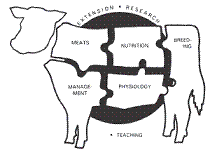Animal Science, Department of
Date of this Version
2017
Citation
2017 Nebraska Beef Cattle Report. University of Nebraska Extension MP104. Lincoln, NE.
Abstract
Plant waxes provide a marker profile of individual plants that, when sufficiently distinct, can be used to estimate the diet composition of grazing cattle. They also may provide a tool for reliably predicting feed intake. The traditional method (nonnegative least squares) to use these markers to predict diet composition has limitations. A newer statistical approach (Bayesian linear unmixing) deemed more efficient was tested with simulation. Samples from 8 forage species in Nebraska were analyzed for their plant- wax marker contents. Those concentrations were used to simulate 1000 diets for 4 mixtures containing 2, 3, 5 or 8 plants. The efficiency of the two methods to predict diet composition was compared. The newer approach outperformed the traditional one in all of the mixtures considered. However, predictions were considerably worse when the number of plants in the mixture was 5 or 8. When forage mixtures are complex, additional steps will be needed to predict diet composition, and thereby feed intake, in grazing cattle.
Included in
Large or Food Animal and Equine Medicine Commons, Meat Science Commons, Veterinary Preventive Medicine, Epidemiology, and Public Health Commons



Comments
© 2016 The Board Regents of the University of Nebraska.